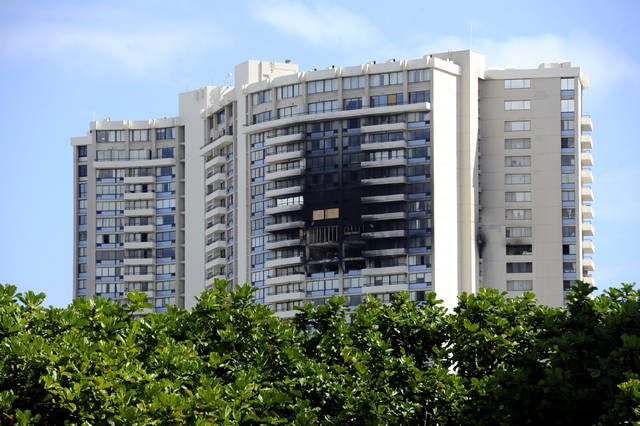Marco Polo high-rise had outdated fire alarms

BRUCE ASATO / BASATO@STARADVERTISER.COM
The Marco Polo high rise apartment building seen from the Honolulu Stadium State Park.
A Honolulu apartment high-rise where a blaze recently killed three people failed to update its fire alarms to meet safety standards despite an engineering firm recommending the changes after another fire four years ago, city records show.
The Associated Press acquired the engineering firm’s 2013 report, which found fire alarms in the 36-story complex did not meet the city’s fire code because they were not loud enough and did not have flashing lights. The firm recommended replacing the system.
The residential tower built in 1971 was not required, however, to meet the standards because they were not part of the fire code at that time, so property managers broke no laws. Several residents said they had trouble hearing the fire alarms during the July 14 fire, and fire safety experts say those warnings are crucial to saving lives.
The Honolulu Fire Department declined to release its inspection records for the Marco Polo building, citing the ongoing investigation. An AP review of permits filed with the city’s Department of Planning and Permitting revealed that building managers never applied for permits to upgrade the system.
The city follows the National Fire Protection Association’s 2012 standards, which require new buildings to have alarms that are loud enough to be heard in apartments, strobe lights or other visual aids installed in common areas, and hallways with smoke detectors.
Honolulu only requires older buildings to bring their alarm systems up to code during a major renovation, said Curtis Lum, spokesman for the planning department.
Don't miss out on what's happening!
Stay in touch with breaking news, as it happens, conveniently in your email inbox. It's FREE!
Building managers commissioned a fire safety assessment by the engineering firm S.S. Dannaway after the 2013 fire. It found that fire alarms within the apartments were not loud enough and recommended adding speakers to the main living areas and bedrooms of every unit.
It also said the system did not have visual triggers in hallways or common areas and didn’t detect smoke in inside hallways.
“You have to have a working fire alarm system that can notify the occupants in the event of a fire,” said Samuel Dannaway, lead author of the report and now vice president of fire protection technology with Coffman Engineers. “It’s extremely important. It’s so basic to what we do, especially in these very tall buildings.”
His report recommended replacing the system at a cost of $1.2 million, but that never happened. It also suggested adding a sprinkler system for $4.5 million, which also was not done but isn’t required of older buildings in Hawaii and many other places.
After this month’s fire, Honolulu Mayor Kirk Caldwell introduced a measure to require residential high-rises to install sprinkler systems and have audible fire alarms throughout the building.
Several residents who escaped the blaze, which broke out on the 26th floor, said they didn’t realize they were in danger until they opened their doors.
“It didn’t sound quite like a normal, traditional fire alarm,” said Air Force cyber-technician Cory La Roe, who lives on the fifth floor, adding that there were no announcements or flashing lights when the fire ignited.
Gordon Kihune, who has lived in the building for about 12 years, said he didn’t hear the alarms until he opened his apartment door on the 13th floor. He said he has a hearing problem and there were no lights for people who are hearing impaired.
Angela Kim, who lives on the 30th floor, said she can only hear the sirens if her apartment door is open.
Michael Anderson on the 17th floor said he has heard alarms and seen flashing lights at the end of the hallway during fire drills.
“If people on the fire floor . didn’t hear the alarm, that would be a yellow or red flag for the investigators,” said Robert Solomon, a fire protection engineer with the National Fire Protection Association.
The organization sets safety standards for local, state and federal jurisdictions to adopt. It says high-rises, especially those without sprinkler systems, should have alarm systems with loud sirens, flashing lights, a voice announcement system for firefighters to guide evacuations and self-closing doors to help prevent flames from spreading.
The association’s guidelines do not require updated fire alarms in older buildings to bring them up to code unless the system is so old that replacement parts cannot be found or other problems lead fire departments to mandate it, Solomon said.
Dannaway said his firm inspected several other Honolulu high-rise buildings with old fire alarm systems and “all of them have that same audibility problem.”
Asked whether the Marco Polo high-rise had made any of the changes recommended in 2013, Andrew Fortin, spokesman for Associa Hawaii, which manages the building, said he could not comment because the questions were the subject of the ongoing investigation.
Honolulu Fire Capt. David Jenkins said he could not answer for the same reason.
Longtime resident Thomas Schmidt, who lives on the 26th floor close to where the fire started, said many apartments have louvered doors with horizontal slats that allow ocean breezes to cool the units, but he said those doors may have contributed to the fire’s spread.
“I’m absolutely overwhelmed with joy that I’m still here, because my neighbors across the hall are all dead,” said Schmidt, 74. “If we had been home, I might have got burned up in the fire, too.”
Associated Press writers Caleb Jones, Jennifer Sinco Kelleher and Marco Garcia contributed to this report.



